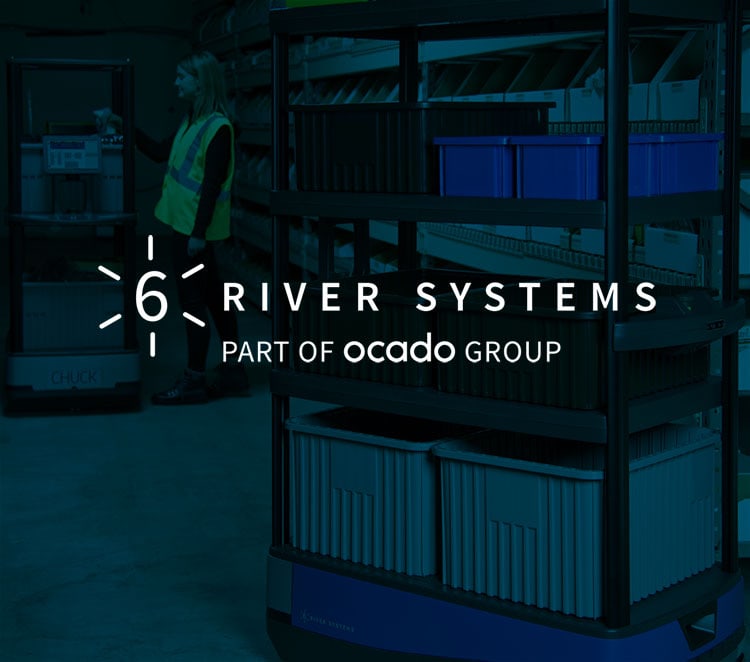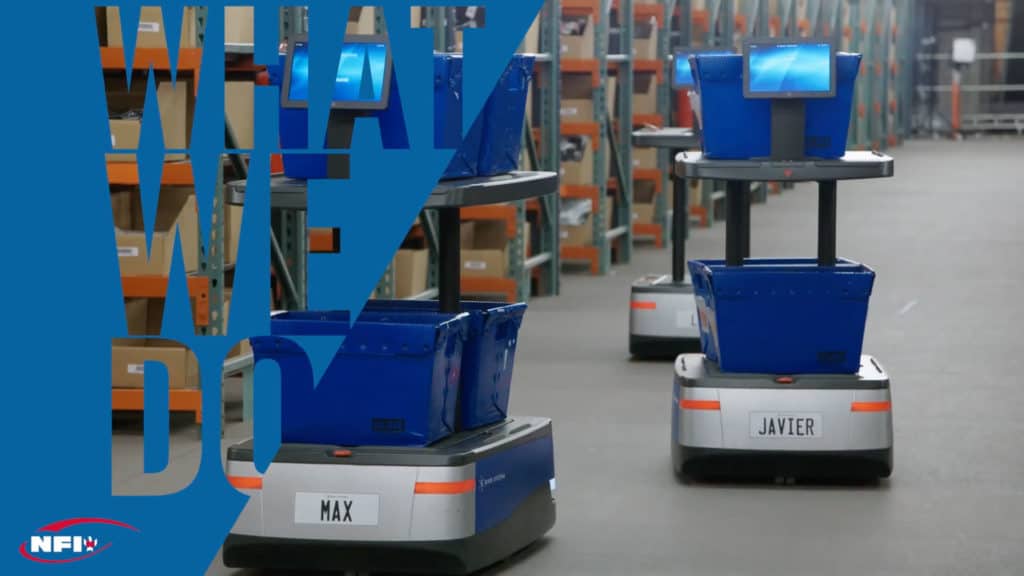As we move forward in the age of ever-evolving warehousing technology, it’s safe to say that all workplaces are in the midst of change. Today, as companies across every industry face constant pressure to do more with less, efficiency is the name of the game. This is especially true in the warehousing industry, being a critical component of the supply chain. Fortunately, the technologies available to the modern warehouse are growing more sophisticated all the time. 
The warehouses of the future might not look like a scene out of Bladerunner, but what’s in store for the industry over the next decade? Warehouses will build on current effective process-driven technologies, such as widespread supply chain automation, hyper-effective robotic technologies and, yes, plenty of drones to go around.
Let’s take a look at concepts of warehousing and what to expect for the future of warehouses.
In this guide, we’ll discuss:
- Supply chain challenges driving change
- The logistics marketplace
- Advances in tracking and visibility
- Advanced warehouse automation
- Big data and machine learning
- Autonomous vehicles
- Considerations for the warehouse of the future
- More resources on the warehouse of the future
Keep reading to find out how your company can shore up your warehouse operations using these up-and-coming technologies.
Supply chain challenges driving change

Warehouses face a number of challenges. Retail footprints are shrinking as more consumers opt to purchase online. For warehouses, that means shouldering a larger storage burden to compensate for the shift from brick-and-mortar shopping to e-commerce. That translates to an increased staffing need, which is only further complicated by tight labor markets.
During peak periods, warehouses can experience 3-5x volume spikes. Most warehouses are very manual as traditional hardware and software solutions are only accessible to the largest companies. A very manual warehouse leads to slow processes, inefficient workflows and being prone to human errors. This creates a need across many companies for scalable solutions that don’t require a substantial CapEx investment — and, ideally, work with a warehouse’s existing infrastructure and layout.
Consumer behavior continues to shift in response to the latest warehouse technologies and capabilities of modern retailers. With major players like Amazon catering to the demand for rapid shipping, other retailers are forced to follow suit or be left behind. Ultimately, meeting these demands falls on the warehouse. It seems an insurmountable challenge, requiring the ability to ship larger and larger items individually, rather than by the truckload, and in two days instead of weeks — all at the same or lower pricing. An impossible feat or not, consumers are putting their money where their mouths are:
- 66% of consumers have chosen one e-commerce vendor over another based on delivery options (Accenture).
- 54% of consumers consider “fast shipping” to be two days or less, and 64% of consumers are not willing to pay more for two-day shipping (Deloitte).
- 77% of consumers say they’re more likely to do business with the same retailer again after receiving free or fast shipping (Dropoff, Inc.).
As retailers are forced to meet these demands in order to attract and retain customers, they’ll look to warehousing and distribution partners with the capabilities to meet those needs. And that’s what’s driving the trends in warehousing and technologies that are shaping the warehouse of the future. Below, we’ll talk about the shifts underway and up-and-coming innovations that are transforming the warehouse.
The logistics marketplace

Warehouses, and the supply chain as a whole, are moving to a more integrated approach that supports transparency and visibility, for the warehouse, its logistics partners and consumers. Let’s look at a few trends in the logistics marketplace that will influence the warehouse of the future.
Effective capacity management is the foundation of a functional warehouse. Capacity planning is complex, though, requiring ongoing analysis of the four Ps: product, promotion, peak and predicament. If capacity management isn’t a priority, many warehouses find that slow-moving (or obsolete) inventory has quickly taken over all available space when you need it most. The warehouse of the future will take advantage of automated capacity management by leveraging technology for better, data-driven capacity planning. The result is fewer capacity planning errors that can lead to lost revenue and improved space utilization, which translates to a healthier bottom line.
On-demand warehousing is another trend to emerge from the need for greater warehouse flexibility to accommodate temporary demand for additional capacity. This trend enables companies who have built their warehouse to handle their peak season demands to monetize unused space during quieter times of the year.
Automation as a service is a fast growing business model where customers can deploy automation on an as needed basis. It’s gaining prominence because it provides facilities with the ability to rapidly scale up and down as demand dictates and allows buyers to expand or experiment with technologies such as robotics without going through a rigorous purchasing process.
The growth of open-source technologies and cloud-based services means applications are better able to share data than ever before. This connectivity is supported by APIs, allowing applications to seamlessly collect data from disparate warehouse information systems. The information silos that exist in today’s supply chain will vanish in the warehouse of the future thanks to completely integrated technologies.
Along with the connectivity made possible by APIs, the logistics marketplace will be able to take advantage of multi-modal optimization through seamless integration with vendors, logistics providers and other supply chain partners. Multi-modal optimization allows for sophisticated planning across regions, routes, modes of transport and more to easily achieve lead time and cost goals.
Advances in tracking and visibility

The Internet of Things (IoT) is already shaking up the world of warehousing. IoT fosters better communication and collaboration between supply chain partners, plus greater accountability across the board. IoT adoption will continue to grow over the next decade as technology costs are now within reach for many warehouses and warehouse logistics operations. Other benefits of IoT include:
- The ability to readily identify risks in the supply chain
- Provides real-time data on weather and other conditions causing shipment delays
- Helps companies meet chain-of-custody regulations for sensitive cargo
- Reduces damaged and lost goods, as well as equipment damage
- Precise location data reduces the time it takes to locate specific inventory
- Improves inventory management and forecasting accuracy
The IoT is just one of several driving forces behind the trend toward end-to-end supply chain visibility. Another key element is real-time tracking, supported in part by IoT as well as technologies such as RFID and other real-time location systems (RTLS).
Mobility is also playing a significant role in the modern warehouse. The proliferation of mobile devices, such as smartphones and tablets, means warehouse workers and logistics partners have a wealth of tools and resources at their fingertips. Scanning inventory with barcode scanning apps, viewing the precise location of a shipment on a map, pulling up detailed shipping and receiving data and generating reports in seconds are just a few of the many functions made possible by mobile. At-your-fingertips access to essential tools and data means greater visibility everywhere — the office, the receiving department, the floor and the field.
A survey of 143 professionals in North America and Europe conducted by VDC Research found that most respondents are committed to modernizing their warehouse operations with smart technology investments, including mobile devices and applications. However, as reported by Invanti, more than half of IT decision-makers surveyed (53%) consider their mobility deployments immature.
According to the GEODIS 2017 Supply Chain Worldwide survey, full supply chain visibility was the third most important strategic priority for companies in 2017, but surprisingly, just 6% of companies had achieved this goal. One challenge is that 70% of companies describe their supply chains as either very or extremely complex. Thanks to the greater accessibility of technologies required to support it, more warehouses will be achieving end-to-end supply chain visibility over the next decade.
Advanced warehouse automation

When it comes to boosting warehouse operations, many experts say the smartest approach that a company can take is to invest in automation. Although automation has been around for decades (maybe centuries!) in one form or another, innovative businesses are focused on incorporating autonomous elements into their existing infrastructure and systems to transform the fulfillment process without a total infrastructure upheaval.
Technologies like Chuck, our completely customizable, autonomous collaborative robot that uses the very same sensors found in self-driving vehicles, stand in as robotic “workhorses.” They never tire, even when running 24/7, and provide near-perfect success rates, which cuts out the human errors which arise in manual cart picking operations.
Before the appearance of tools like Chuck, companies integrating more inflexible robotic alternatives were often forced to start completely from scratch and redesign their warehouse. Complex infrastructure upgrades and months-long wait before those systems were fully functional meant achieving ROI was a long-term goal, not a short-term one.
Another trend in warehouse automation is augmented reality (AR), which can be used to increase the efficiency of the order picking process and reduce on-the-job training needs. Virtual reality (VR), AR’s cousin, is also making waves in improving the safety and efficiency of the delivery process. VR can also enhance secure delivery and identity verification through facial recognition technology and other advances.
Drones are likely to have a role in the warehouse of the future, as well. In August of 2017, researchers at MIT announced that they had been programming drones to relay RFID as a way to aid in inventory control — an innovation that could make tagging obsolete in the future. This technology allows small drones to fly above a warehouse floor to read RFID tags from tens of meters away, with an impressive 19-centimeter margin of error. The hope here is that the drones will be able to read existing RFID tags, without the need for the warehouse to purchase new tags, readers or reader software.
At the moment, there are a few things holding back drones from becoming part of the warehouse team at all companies, with the chief concern having to do with safety. Current regulations dictate that only a specialized class of lightweight aerial drones can be used in warehouses, but these drones may lack the capabilities needed to accurately read RFID tags from a distance.
Within the next several years, industry leaders predict that many warehouses will be able to use drones to track their inventory. This will give warehouses of all sizes the ability to conduct comprehensive inventory counts and audits at the drop of a hat.
Advanced sortation systems are already being leveraged by some warehouses and adoption of these technologies will continue to grow for the highest volume largest retailers in the world. Advanced sortation systems have a very high cost per user which means it’s often only the largest companies in the world who can afford such an investment. Sorters and shuttles provide fast unit or parcel sorting for applications such as direct-to-consumer order fulfillment, retail and even returns processing, among others.
For more on sortation, read “How Sortation Boosts Your Competitive Advantage.”
Big data and machine learning

Big data and machine learning aren’t new concepts, but they’re poised to transform warehouse operations over the next few years. Artificial intelligence, for instance, can be applied to a number of use cases in the warehouse. Thus, one of the main challenges facing warehouse leaders when it comes to big data and machine learning is to identify key business drivers (or KPIs) and then determine how to best apply AI to improve them.
Order picking accuracy, fulfillment time and inventory accuracy are all KPIs that can be optimized through the use of AI, while some may apply AI to more general drivers such as safety, productivity or facility damage. By analyzing aggregated data from various information systems within the warehouse, AI can be used to automate tasks and decision-making.
Advanced analytics, such as predictive analytics, are leveraged to improve forecasting and drive smarter decision-making in the warehouse. Advanced analytics can be applied to use cases such as:
- Accurate demand forecasting
- Smarter inventory location planning
- Clarifying stock demand value
- Risk reduction, even with more complex supplier networks
- Rapid response to supply chain issues
- Manage complexity and demand resulting from new channels
- Intelligent optimization of picking, storage and more
Advanced analytics can also result in more user-friendly data — that is, data visualizations and other easily digestible formats, making it simpler to derive actionable insights from data. Data visualization, along with advanced analytics, will play a crucial role in achieving end-to-end supply chain visibility discussed earlier in this guide.
Autonomous road vehicles

Autonomous vehicles, once considered a pipe dream, are well within reach for the warehouse of the future. Companies like Uber, Waymo (under parent company Google) and Drive.ai have already taken the self-driving car concept to the streets. But what about the warehouse? There are a few developments bringing the concept of autonomous vehicles to the warehouse:
- Platooning is a strategy that utilizes forward-collision avoidance systems coupled with vehicle-to-vehicle communication that enables two or more trucks to travel in close proximity, resulting in lower wind resistance and fuel economy savings for both vehicles. The truck at the front of the convoy serves as the leader, while the trucks following adapt and react to changes in the head truck’s movements via technology. While each truck has a driver who remains in complete control of the vehicle, these technology-driven reactions take place with little to no action on the driver’s part.
- Driver-assisted vehicles aren’t fully autonomous. Instead, a driver-assisted vehicle relies on technology supplemented by the driver, rather than drivers supplemented by technology (known as driver-assist).
- Full-autonomous vehicles would operate without the aid of a driver, or with a driver monitoring the vehicle remotely with the ability to take control at any time. In this case, a driver could potentially monitor several vehicles at the same time.
Considerations for the warehouse of the future
It’s not as simple as it may seem to simply adopt the latest technologies for today’s warehouses. In terms of warehousing design, existing facilities typically have legacy designs and layouts, so to be successful new automation must be both flexible and minimally disruptive without significant increases in capital expenses.
Finally, labor shortages mean that warehouse will look to ways to increase productivity, automation tools that are simple to use and easy to train workers on and change the nature of the work in order to attract new labor.
Warehouses have played an integral role in the supply chain for decades, yet there’s no chance the warehouse will become obsolete. Instead, the future looks bright for the warehousing industry as innovative, forward-thinking companies pave the way for the warehouse of the future by embracing the latest advancements in technology. Interested in more? Let’s discuss the solution that’s right for you. Contact us today.
More resources on what warehouses will look like in 10 years
For the latest information on the future of warehouse technology, including robots, drones, and evolved supply chain management, visit the following resources:
- The Past, Present, and Future of Technology in the Warehouse
- How E-Commerce is Changing the Future of Warehouses
- Changing the Future of Warehouses with Amazon Robots
- The Warehouse of the Future
- The Flying Drones that Can Scan Packages Night and Day
- Drones in the Warehouse–Will They Take Off?
- Making Sense of Collaborative Robots
- 7 Common Applications for Cobots
- Next Generation Supply Chain Visibility
- Future of Supply Chains 2025


